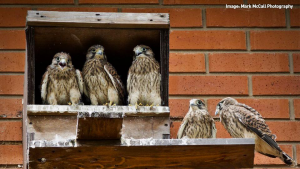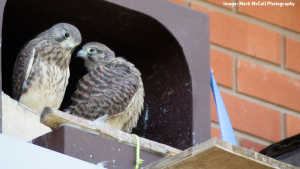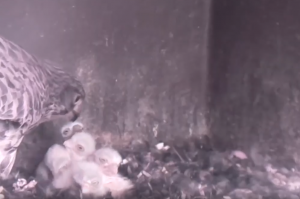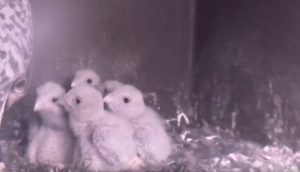Campus kestrels: how it all started
There’s been a lot of buzz around the campus kestrels this year! With the live stream documenting every moment and the success of this year’s chicks, we wanted to find out more. We met with Mark Hillman (Senior Arborist) to get an insight into how it all started!
To watch the live stream click here.
What are kestrels?
Kestrels are birds of prey that belong to the falcon genus. The kestrels on campus are European Kestrels and they are native to Britain. They will be in Britain all year round but only in Loughborough from around March until July. It’s likely that the kestrels were drawn to the area due to the abundance of wildlife on campus, which provides a perfect hunting ground. Kestrels will mate for life, so we think it’s the same pair that return to Loughborough campus each year. You can tell the difference between male and female as the male is slightly smaller than the female and a bit more colourful as his back is more spotted. His head has fewer stripes and is slate grey, whereas the females back have more barred type markings.
How did it all start?
Around 6 years ago the Facilities Management team noticed that the kestrels were trying to nest on an old platform on one of the buildings down by Holywell. They decided to build a box for the kestrels to nest in. In order to make sure it suited their needs, so the kestrels would nest there, the team used gravel, woodchips, and sawdust to fill the nest to make a bevel shape. They also made sure it was facing the direction where the kestrels would get sun in the morning and shade in the afternoon and gave it an open approach. The team decided to put in a live stream camera in the box as it allows them to monitor the chicks and learn what they are feeding on, so they can help to encourage more of that type of wildlife in the area.
How are this year’s chicks doing?
It’s very exciting that the female kestrel laid five eggs and all five have hatched this year! Whilst still in their eggs, the female kestrel will stop hunting to incubate the eggs for about four weeks, relying on the male to continue to bring her food. If the eggs are left alone they can be threatened by other birds such as magpies. Since hatched, they all appear to be doing well with the female kestrel being a good mother, ensuring that they are being kept warm until they can control their own body temperatures. The male kestrel will continue to bring food for the chicks and their mother until they are ready to fledge. This year it appears that they are mainly feeding on mice and small birds! It’s impossible to tell the sex of the juveniles because they will all look the same until the first malt, which will happen next spring.
So what happens next?
Two weeks after the eggs have hatched the chicks will begin to get new feathers and they will start preening themselves. Then after about a month after hatching, they will fledge, spending a final few weeks with their parents learning to hunt within the Loughborough area. Finally, they will separate once they can fend for themselves and the parents will hopefully return in March 2020. The chicks will not be mature enough to breed until their second year. Mark’s task after they leave will be to clean out the new fiberglass box so it’s ready and prepare a new nest. The team hopes to reposition the camera so people will be able to watch the kestrels come and go as well as nesting.
Sustainability and Facilities Management are doing an amazing job of encouraging wildlife on campus, including putting down extra grain during cold winters to provide food for mice and birds. If you want to find out more about the wildlife on campus click here.
Loughborough Life
The Loughborough Life blog features all the latest events from across our campuses. Find out what's happening near you and get involved.



